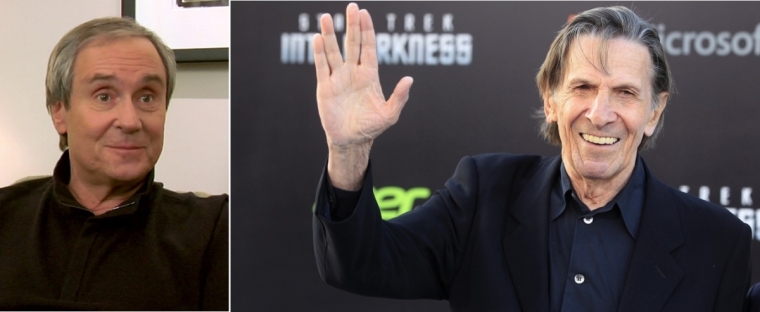Leonard Nimoy, Maurice Hurley Dead: 'Star Trek' Writer and Mr. Spock Pass Away In Same Week

Leonard Nimoy turned out to be the second member of the "Star Trek" franchise to have died last week. Three days before the 83-year-old Nimoy lost his battle against chronic obstructive pulmonary disease, Maurice Hurley, a writer and producer for "Star Trek: The Next Generation," was the first one to go on Tuesday last week. He was 75.
Rick Berman, the executive producer of the series, announced Hurley's death. "We lost one of Star Trek's most talented minds. Maurice Hurley produced seasons 1 and 2 of TNG. He was one of a kind. So very sad," Berman said in a post on Twitter, according to The Hollywood Reporter.
Hurley also had a hand in writing a dozen episodes of the syndicated Paramount Television series, which aired from 1987 to 1994.
Fans of the show know him as the creator of the powerful Borg pseudo-species.
Hurley also wrote the screenplays for "Firebird 2015 AD" in 1981 and "Groom Lake," which starred William Shatner in 2002.
A native of Boston, Hurley also co-created the series "Pointman," which starred Jack Scalia as the owner of a beach resort who helps out those in trouble in 1995.
He also worked on "24," "La Femme Nikita," "The Equalizer," "Kung Fu: The Legend Continues," "Baywatch," "Baywatch Nights" and "Diagnosis Murder."
Hurley's death preceded that of Nimoy, the actor behind the ever-logical Mr. Spock in "Star Trek'' on TV and the big screen, who died at his Bel-Air home on Friday.
His wife, Susan Bay Nimoy, confirmed his death, saying the cause was end-stage chronic obstructive pulmonary disease.
Nimoy had been suffering from disease aside from bronchitis and emphysema. Last year, Nimoy revealed that he was ill and blamed his years of smoking for this.
Premiering on NBC in September 1966, "Star Trek" made Nimoy a star with the franchise creator Gene Roddenberry calling him "the conscience of 'Star Trek'" — an often earnest, sometimes campy show that employed the distant future to take on social issues of the 1960s.
 Christians don't have to affirm transgenderism, but they can’t express that view at work: tribunal
Christians don't have to affirm transgenderism, but they can’t express that view at work: tribunal Archaeology discovery: Medieval Christian prayer beads found on Holy Island
Archaeology discovery: Medieval Christian prayer beads found on Holy Island Presbyterian Church in America votes to leave National Association of Evangelicals
Presbyterian Church in America votes to leave National Association of Evangelicals Over 50 killed in 'vile and satanic' attack at Nigerian church on Pentecost Sunday
Over 50 killed in 'vile and satanic' attack at Nigerian church on Pentecost Sunday Ukrainian Orthodox Church severs ties with Moscow over Patriarch Kirill's support for Putin's war
Ukrainian Orthodox Church severs ties with Moscow over Patriarch Kirill's support for Putin's war Islamic State kills 20 Nigerian Christians as revenge for US airstrike
Islamic State kills 20 Nigerian Christians as revenge for US airstrike Man who served 33 years in prison for murder leads inmates to Christ
Man who served 33 years in prison for murder leads inmates to Christ


 Nigerian student beaten to death, body burned over ‘blasphemous’ WhatsApp message
Nigerian student beaten to death, body burned over ‘blasphemous’ WhatsApp message 'A new low': World reacts after Hong Kong arrests 90-year-old Cardinal Joseph Zen
'A new low': World reacts after Hong Kong arrests 90-year-old Cardinal Joseph Zen Iran sentences Christian man to 10 years in prison for hosting house church worship gathering
Iran sentences Christian man to 10 years in prison for hosting house church worship gathering French Guyana: Pastor shot dead, church set on fire after meeting delegation of Evangelicals
French Guyana: Pastor shot dead, church set on fire after meeting delegation of Evangelicals ‘Talking Jesus’ report finds only 6% of UK adults identify as practicing Christians
‘Talking Jesus’ report finds only 6% of UK adults identify as practicing Christians Mission Eurasia ministry center blown up in Ukraine, hundreds of Bibles destroyed: 'God will provide'
Mission Eurasia ministry center blown up in Ukraine, hundreds of Bibles destroyed: 'God will provide' Church holds service for first time after ISIS desecrated it 8 years ago
Church holds service for first time after ISIS desecrated it 8 years ago Burger King apologizes for 'offensive campaign' using Jesus' words at the Last Supper
Burger King apologizes for 'offensive campaign' using Jesus' words at the Last Supper Uganda: Muslims abduct teacher, burn him inside mosque for praying in Christ’s name
Uganda: Muslims abduct teacher, burn him inside mosque for praying in Christ’s name